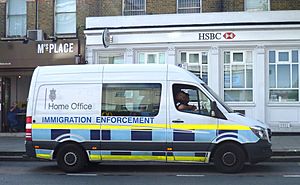UK Immigration Service facts for kids
The United Kingdom Immigration Service was a special group that managed who could enter and stay in the UK. It was part of the Home Office, which is a government department. This service used to be called the Aliens Branch and later the Immigration Branch.
Until it closed down in 2007, the UK Immigration Service was in charge of checking people at the UK's borders. This included 57 different places like airports, seaports, the land border with Ireland, and the Channel Tunnel. They also had a team inside the country. This team found people who had broken immigration rules, such as those who entered illegally or stayed longer than allowed. They also dealt with people working without permission.
The main law that gave the Immigration Service its powers was the Immigration Act 1971. This law started on January 1, 1973. Other important laws that helped guide their work included:
- British Nationality Act 1981
- Immigration Act 1988
- Asylum and Immigration Appeals Act 1993
- Immigration and Asylum Act 1999
- Nationality, Immigration and Asylum Act 2002
- UK Borders Act 2007
In its early years, the Immigration Service mainly focused on controlling passengers and ship crews at seaports. By the 1920s, the service was split into different areas, each led by an Inspector. Immigration Officers had to be over 25 years old. Those younger than 25 were Assistant Immigration Officers.
By the late 1950s, more people started arriving by plane than by ship. So, the service began to put more staff at airports. From the late 1990s, there was a new focus on checking passengers even before they arrived, at visa offices abroad. In the 2000s, new technology helped create a more flexible border control. This allowed them to focus more on passengers who might be a higher risk.
Before 1973, there were not many resources to deal with people who broke immigration rules inside the country. The police usually handled finding people who might need to be deported. The team that enforced these rules grew slowly in the 1980s and 1990s. By 2006, this team removed more people from inside the UK than were stopped at the borders.
In 2007, the part of the Immigration Service that worked at ports started wearing uniforms for the first time. The enforcement part of the service was then split up into new regional teams. In April 2007, staff were told that the UK Immigration Service would no longer exist as a separate group. Its staff moved to new agencies like the Border and Immigration Agency, then the UK Border Agency, and now UK Visas and Immigration, Border Force, and Immigration Enforcement.
Contents
How the Service Worked
Who Made Decisions
The UK Immigration Service had different levels of staff. An Immigration Officer could decide to stop someone from entering the UK. But this decision needed approval from a Chief Immigration Officer or an HM Immigration Inspector.
If someone was already in the UK and broke immigration law, an Immigration Officer or a caseworker could decide they needed to leave. This decision also needed approval from a Chief Immigration Officer or a higher-level officer. Only an HM Inspector or Senior Executive Officer could give the final approval for someone to be removed. Immigration Officers could also deal with immigration rule-breakers through the criminal justice system.
In the early days, Assistant Immigration Officers were common. But this role was stopped when the age rule for becoming an Immigration Officer was removed. The Assistant Immigration Officer role was brought back in 1991. However, their duties were not always clear, leading to discussions with the unions that represented the staff.
Today, if you want to move to the UK from outside Europe, it's usually based on a five-tier system. This system includes different types of visas for skilled workers, students, and temporary workers. Immigration Officers review these applications.
Checking People at Borders
The way the Immigration Service worked depended on whether they were at a port of entry or dealing with people already in the country. All staff followed the main laws in the Immigration and Nationality Acts. But at ports, they used specific rules called the Immigration Rules. These rules explain how the law should be used every day.
Immigration law can sometimes be complicated. Officers at ports have to check many people arriving. They have some freedom in how they apply the rules, though less than before. An officer must get approval from a Chief Immigration Officer to refuse someone entry.
For visitors, an Immigration Officer must be "satisfied" that the person is a real visitor. This means they believe the person does not plan to stay longer than allowed or work illegally. This idea, where an officer just needs to be "satisfied" rather than proving a crime, has caused some legal discussions.
In practice, an Immigration Officer will talk to the person in detail. They will look for other evidence and present a strong case to a Chief Immigration Officer before refusing entry. The job of an officer at a port is to quickly check arriving passengers. They look for anyone whose reasons for visiting seem concerning.
The officer briefly talks to everyone who is not a British Citizen or an EU national. They check documents for fakes, confirm any entry permits, and look at past travel stamps. They also check against warning lists. All of this usually happens in less than two minutes. If the officer is satisfied, they stamp the passport with specific conditions and a time limit for the stay. Officers are under pressure to do this quickly to keep waiting times short. Their performance is judged on how well they interview people, make decisions, and investigate.
See also
- UK immigration control - history
- UK immigration enforcement
- Immigration to the United Kingdom since 1922
- Historical immigration to Great Britain
- History of British nationality law
- Asylum and Immigration Tribunal
Images for kids



